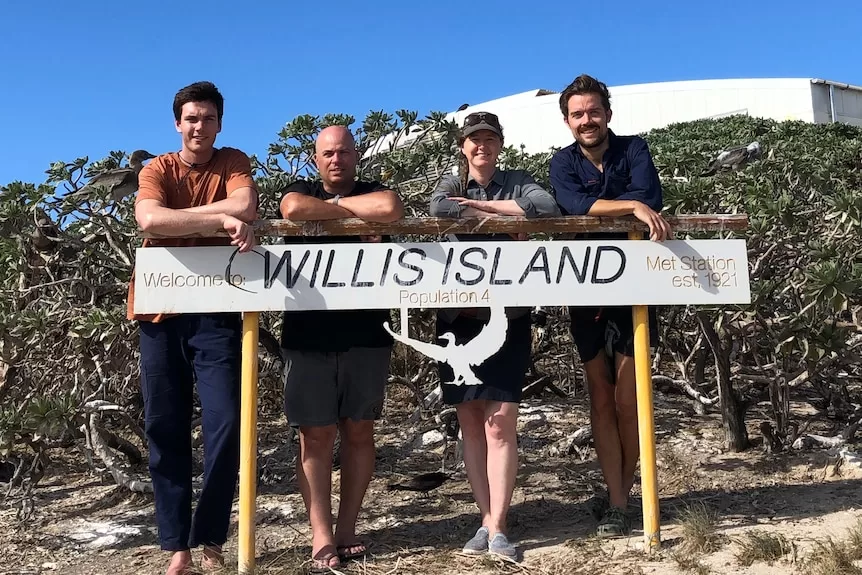Welcome to Willis Island: population four.
The tiny atoll is a speck in the Coral Sea — a two-day, 450-kilometre boat journey from Cairns.
For the island’s only residents, who work as weather observers for the Bureau of Meteorology (BOM), isolation comes with the territory.
“Out here, there’s no-one,” station officer-in-charge William Tom said.
“It’s us and 10,000 birds.”
Willis Island is one of the world’s most remote weather stations.
It was built in the 1920s to serve as an early warning beacon for cyclones and storms, and has been providing continuous weather observations ever since.
Life in isolation
The island’s four weather bureau staff rotate every six months.
All supplies — technical, medical and edible — are brought over by boat during the changeover.
Everything going to plan, the weather observers are unlikely to see another person, or bag of groceries, until the vessel returns to pick them up at the end of their posting.
“You watch [the boat] head over the horizon and walk back up to the station with just the four of you, and it kind of sinks in,” Mr Tom said.
“Like, ‘Oh wow, this is it’ — it definitely hit me in that moment.
“This summer tour means that we’ve been away for Christmas, and New Years, and will all have our birthdays out here on the island.”
The team launches two balloons a day to record the weather.
They grow fresh herbs and vegetables to complement their food stocks and get fresh water from a desalination plant.
For Mr Tom, the job couldn’t be further from the career in music he was pursuing before the pandemic struck, which left him looking for a more stable income.
“It’s all fairly new to me, but I’ve jumped in with both feet and said yes to a lot of opportunities and now find myself here,” he said.
To stave off the loneliness, he keeps in regular contact with family back home and follows the NRL.
“It’s always nice to feel connected to the mainland and regular life by being a viewer of a live event that you know people back home are watching,” he said.
Tropical paradise and plenty of poo
Life on a tropical island has its perks.
Every day, Mr Tom goes for a walk around the island — a lap that takes about 20 minutes.
“If the weather is good, then I’ll go for a quick swim as well, maybe even a snorkel,” he said.
“The reef around the island is beautiful, and on a good day, you kind of feel like you’re holidaying at a beautiful tropical resort.”
But there are downsides too.
Sharing the island with an abundant avian population means cleaning up bird poo is a constant job.
Staring down a cyclone
Over the decades, Willis Island has been in the firing line of several tropical cyclones.
Cyclone Yasi in 2011 caused extensive damage to the station’s equipment, as well as the island’s flora and fauna.
In December 2023, the Bureau of Meteorology team found itself closely monitoring the path of Cyclone Jasper.
“It was pretty exciting, and very rare actually, to have a tropical cyclone form that early in the tour,” Mr Tom said.
But their excitement soon mingled with anxiety when the system made a dogleg turn directly for the island.
“We packed up our rooms, packed up everything and put them into the met office just in case — we didn’t know what was going to happen,” Mr Tom said.
A plan was hatched to evacuate the team onto a nearby Navy ship, with the staff choppered one-one-by to safety in treacherous conditions.
“It was just incredible to suddenly be whisked into this world of high action,” Mr Tom said.
“It was really like something out of a movie.”
Loading…
After 11 days on the mainland, the team returned to the island, which had suffered only minor damage.
“Luckily, when we came back out, we got to bring some more fresh fruit and food supplies … so that was really nice,” Mr Tom said.
“Getting a whole fresh box of tomatoes is just such a treat. When you’re out here you don’t realise how much you take for granted having a juicy ripe tomato to have on a ham sandwich.”
Resisting automation
Willis Island is remarkable not just for its isolation, but the fact that it is now one of the only BOM weather stations that has not moved to automation.
“In the wet season, we’re getting cyclones and storms and rain continuously, not to mention the deleterious effects of having 10,000 birds cohabiting on the island,” Mr Tom said.
“So to have the gear here, and to keep it running, you really need a staff of people on site 24/7.”
The current crop of weather bureau personnel finish their six-month posting this month, and leaving Willis Island will be bittersweet.
“A goldfish grows to suit the size of its bowl — you fill the space,” Mr Tom said.
“You get used to not being able to just head over to your folks’ place for dinner or catch up with friends for a cup of coffee. It’s a different style of life.
“There are hard weeks, certainly, but there’s more than enough stuff to keep you busy.”
Find more local news
Browse for your location and find more local ABC News and information
